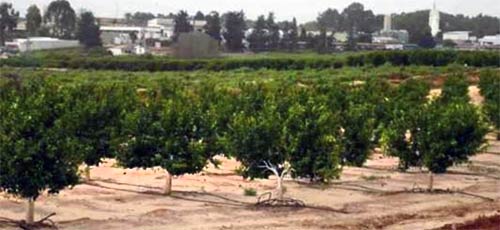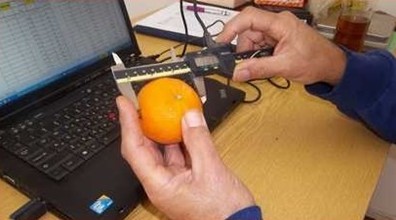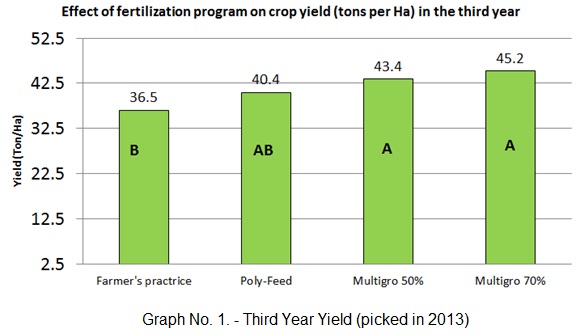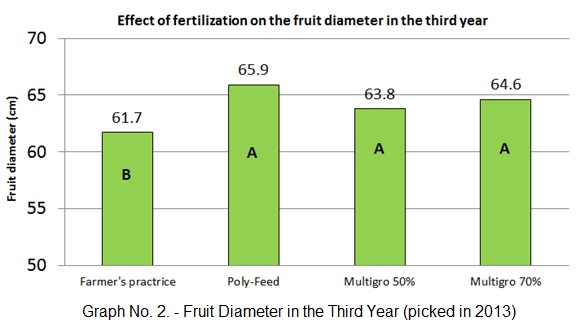Ένα σαφές πλεονέκτημα χρησιμοποιώντας το Poly-Feed ™ με βάση το νιτρικό κάλιο και με λίπασμα ελεγχόμενης απελευθέρωσης ως πηγή μη χλωριούχου καλίου στην ποικιλία OR (easy peeler).. Μια έρευνα από τον Yossi Sofer (ομάδα Haifa), τον Dubbi Rever (Υπηρεσία Γεωργικής Επέκτασης του Ισραήλ)
Περίληψη
Πραγματοποιήθηκε πείραμα στο Kibbutz Naan κατά τα έτη 2008 έως 2013 με σκοπό την εξέταση διαφόρων προγραμμάτων γονιμοποίησης για την ποικιλία OR (easy peeler).
Πραγματοποιήθηκε σύγκριση μεταξύ του λιπάσματος με υδατοδιαλυτό λίπασμα που περιέχει χλωριούχο λίπασμα του οποίου η πηγή καλίου ήταν το νιτρικό κάλιο (KNO3): το Poly-Feed™ ένα διαλυτό λίπασμα για τη ζύμωση και το ελεγχόμενο απελευθερωμένο λίπασμα (Multicote™ Agri / Multigro™). Για τις θεραπείες Multicote ™ Agri, το λίπασμα χορηγήθηκε σε δόσεις που ήταν 50% -70% του ρυθμού επεξεργασίας με τη λίπανσης.
Η επιρροή του λιπάσματος στην απόδοση και το μέγεθος των καρπών, η περιεκτικότητα σε θρεπτικά στοιχεία στα φύλλα και η ανάπτυξη των δέντρων εξετάστηκαν.
Τα αποτελέσματα του πειράματος έδειξαν ότι όλες οι θεραπείες που δοκιμάστηκαν αύξησαν την απόδοση και τη διάμετρο του κορμού σε σύγκριση με την ομάδα ελέγχου, αλλά δεν υπήρχε διαφορά στην εξέταση των φύλλων. Τα αποτελέσματα των δοκιμών δείχνουν ένα πλεονέκτημα χρησιμοποιώντας την Poly-Feed ™ με βάση το νιτρικό κάλιο και με λίπασμα ελεγχόμενης απελευθέρωσης (σε μειωμένη δόση λιπάσματος) ως πηγή μη χλωριωμένου καλίου στην ποικιλία OR (easy peeler).

Introduction
The OR variety has been the leading easy peeler in Israel for the last several years, with the cultivated area reaching approximately 4,500 Hectares, yielding an average of 35 tons per Ha in the south of Israel and 40 tons per Ha in the central and northern part of the country. Due to its exquisite taste, lack of seeds and easy peeling, the OR variety retrieves high prices abroad. The commercial potential is the reason that most of the research done in the citrus industry in Israel focuses on this variety.
The accepted fertilizer treatment today is fertigation, with the fertilizer equations where the source of potassium is potassium chloride (potash - KCI) due its inexpensive cost as compared to other potassium sources. Between 2008 and 2013 an experiment was carried out which examined the influence of alternative fertilization programs for the OR easy peelers.
In this experiment the use of fertigation with the potassium source being potassium nitrate (Poly-Feed™), and in two doses of controlled released fertilizer (Multicote™ Agri) were examined.
Multicote™ Agri is a polymer coated granular fertilizer, manufactured in Israel by Haifa Group. Multicote™ Agri granules are concealed in the soil, and continuously release their nutritional elements for a number of months. It is available in a wide variety of compositions and release durations for maximum compatibility to the crops' requirements. Multicote™ Agri fertilizer is considered to be more efficient, what enables the use of smaller doses compared to other application methods. Additional advantages of Multicote™ Agri fertilizer are: low risk of being washed away and polluting ground water; reducing salinity in the area around the tree's root zone and therefore improving water absorption; and there is the possibility for differential fertilizing for every tree according to its level of growth (precise agriculture). This study examined the influence of replacing the potassium source from potassium chloride to potassium nitrate on the vegetative and reproductive growth of the orchard; the efficiency of controlled released fertilizer in reduced doses, and the influence of potassium chloride on the tree's potential yield. An economic comparison was made between the various fertilizing programs.
The OR orchard was planted in August 2007 in Kibbutz Naan, Israel, on bitter orange (Citrus aurantium) mounts. The soil in the plot is sandy red loam, and the planting spacing is 5.5 X 3.75 meters (485 trees per Ha). The plot was irrigated during the experiment with waste water. Farmer's practice fertilization program was administered to the entire plot, and not just to the area where the experiment took place.
The Experiment's Treatments:
- Farmer's practice - fertigation with fertilizer containing potassium chloride (KCI).
- Fertigation with Poly-Feed™ - soluble fertilizer that contains potassium from a potassium nitrate source (KNO3).
- Controlled released fertilizer (Multicote™ Agri) with fertilizer levels of 50% and 70% compared to farmer's practice fertilization program.
Farmer's practice fertilizer is determined every year by the grower, and then the specific fertilizer levels in the various treatments are derived.
The experiment was carried out in four completely random repetitions. In each repetition were five trees, where two of them in the middle of the repetition were chosen for the various measurements.
The experiment measured the diameter of the graft and mount approximately 10 cm above and below the connection point, yield (weight per tree and size distribution) and the nutrient levels in leaves.
The first picking was carried out on February 2nd, 2011, the second on January 23rd, 2012, and the third on February 13th, 2013. The examination of leaves was performed on November 17th, 2011 and on November 12th, 2012.
Results
Trunk Diameter
Between 2009 and 2010 no difference was found between the treatments concerning the diameters of the grafts and mounts, except for a significant difference in the diameter of the mount that received 70% Multicote™ Agri treatment, as compared to the farmer's practice treatments of autumn of 2009.
In the following measurement, in the spring of 2010, significance was not apparent. No differences were found in the measurements of the graft and mount diameters in 2011, but the measurements in March 2012 showed that the mount and graft diameter in all the treatments without chloride, and the mount in the 70% Multigro™ treatment were significantly larger from the farmer's practice.
Leaf Examination
In the 2013 spring season new leaf element levels recommendations were released, and in light of these levels the results from the leaf examinations were analyzed. In the measurement of 2011 no significant differences were found between the treatments. It needs to be noted that the levels of nitrogen were quite high, between 2.6% - 2.95%, while the recommended level is between 2.23% - 2.47%. The levels of potassium were high in all of the treatments, between 0.66% and 0.78%, as compared to recommended levels of 0.52% - 0.57%.
- The levels of phosphorous were also high, around 0.14% in all the treatments, whereas the recommended level is between 0.13% - 0.11%. Magnesium levels were on the lower threshold of 0.23%, as compared to the recommended levels being between 0.29% - 0.26%.
- In 2012 the nitrogen level decreased into the acceptable range, and no correlation was found between the nitrogen levels in leaves to the level of the nitrate fertilizer.
- The level of potassium also decreased in all the treatments, except for the Poly-Feed™ treatment, as compared to the previous year - but it was still higher than recommended.
- The phosphorous levels increased as compared to the previous year - this was without administering phosphorous fertilizer in the entire plot. The magnesium level radically decreased in 2012, and reached levels between 0.16% and 0.17% regardless of the treatment.
| Year | Treatment | N% | P% | K% | Mg% |
|---|---|---|---|---|---|
| 2011 | Farmer's practice | 2.91 | 0.13 | 0.78 | 0.23 |
| Poly-Feed™ | 2.62 | 0.14 | 0.65 | 0.24 | |
| Multicote™ Agri 50% | 2.85 | 0.14 | 0.72 | 0.23 | |
| Multicote™ Agri 70% | 2.71 | 0.14 | 0.66 | 0.23 | |
| 2012 | Farmer's practice | 2.42 | 0.15 | 0.69 | 0.16 |
| Poly-Feed™ | 2.34 | 0.18 | 0.69 | 0.17 | |
| Multicote™ Agri 50% | 2.38 | 0.13 | 0.64 | 0.16 | |
| Multicote™ Agri 70% | 2.46 | 0.14 | 0.65 | 0.16 |
Table No. 1 - Leaf Examination
Yield
 In the growing season of 2010 (picked in 2011) there was no difference in yield measurements concerning the number of pieces of fruit grown on the trees; the diameter and average weight of the fruit; and in the overall yield between the various treatments (see Table No. 2).
In the growing season of 2010 (picked in 2011) there was no difference in yield measurements concerning the number of pieces of fruit grown on the trees; the diameter and average weight of the fruit; and in the overall yield between the various treatments (see Table No. 2).
 In the growing season of 2011 (picked in 2012) a significant difference was found between the farmer's practice and the rest of the treatments in all of the aforementioned measurements. The farm yield was approximately 6 tons lower per Ha than the rest of the treatments, the weight of the fruit was significantly lower than the control group when compared to the Multicote™ Agri treatments.
In the growing season of 2011 (picked in 2012) a significant difference was found between the farmer's practice and the rest of the treatments in all of the aforementioned measurements. The farm yield was approximately 6 tons lower per Ha than the rest of the treatments, the weight of the fruit was significantly lower than the control group when compared to the Multicote™ Agri treatments.
The number of fruit was significantly higher with the farmer's practice and Poly-Feed™ treatments as compared to the Multicote™ Agri treatments. The fruit's diameter was smaller than the Poly-Feed™ (not significantly) and from both Multicote™ Agri treatments (significantly). The percent of fruit with a diameter larger than 65 mm in the control group was 51.5%; 69.5% with the Poly-Feed™ and 50% Multicote™ Agri treatment; and 79.1% with the 70% Multicote™ Agri treatment.
In the 2012 growing season (picked in 2013) Multicote™ Agri treatments yielded more fruit per tree in comparison with the farmer's practice and Poly-Feed™ treatments. The diameter and weight of the fruit were significantly smaller in the farmer's practice treatments as opposed to the other treatments (Graph No. 2).
The yield in the control group was significantly lower than all of the treatments and reached 36.5 tons per Ha. The yield from the Poly-Feed™ treatment reached 40 tons per Ha, and for Multicote™ Agri treatments, 43.4 and 45.2 tons per Ha in 50% and 70% treatments accordingly (Graph No. 1). The percentage of fruit with a diameter larger than 65 mm in the control group was 27.3%, 52.8% in Poly-Feed™ treatment, 29.5% with 50% Multicote™ Agri treatment, and 32.4% with 70% Multicote™ Agri.



| Season | The Treatments | Avg. Number of Fruit of the Tree | Avg. Fruit Diameter (mm) | Avg. Fruit Weight (gr) | Yield (kg/tree) | Yield (ton per Ha) |
|---|---|---|---|---|---|---|
| 2010 | Farmer's practice | 110 a | 67 a | 161 a | 17.6 | 11.7 a |
| Poly-Feed™ | 98 a | 69.5 a | 179 a | 17.5 | 11.7 a | |
| Multicote™ Agri 50% | 113 a | 71.6 a | 189 a | 21.4 | 17.8 a | |
| Multicote™ Agri 70% | 99 a | 73 a | 198 a | 19.6 | 13.1 a | |
| 2011 | Farmer's practice | 787 b | 62 b | 114 b | 89.5 | 43.4 b |
| Poly-Feed™ | 803 b | 68.1 a | 130 ab | 104 | 50.7 a | |
| Multicote™ Agri 50% | 647 a | 66 a | 154 a | 99.7 | 48.4 a | |
| Multicote™ Agri 70% | 682 a | 68 a | 144 a | 97.9 | 47.5 a | |
| 2012 | Farmer's practice | 654 ab | 61.7 b | 115 b | 75.3 | 36.5 b |
| Poly-Feed™ | 615 b | 65.9 a | 136 a | 83.3 | 40.4 ab | |
| Multicote™ Agri 50% | 705 a | 63.8 a | 127 a | 89.6 | 43.4 a | |
| Multicote™ Agri 70% | 715 a | 64.6 a | 130 a | 93.3 | 45.2 a |
Table No. 2 - Three Year Yield Data
Discussion
Trunk Diameter
In the years 2008-2010 there was no noticeable difference between the treatments concerning the mount or the graft, except for a significant difference in the diameter of the mount in the measurement of autumn of 2009, but was not evident in the measurements that followed in 2010. In the two measurements that were carried out in 2011, no significant difference was found between the treatments, but the measurement in March 2012 found that the mount in all the treatments without chloride were higher than the farmer's practice fertilizer and the diameter of the 70% Multicote™ Agri was significantly larger than the control group.
Leaf Examination
Significant differences were not observed between the treatments during the two years of the study. The level of elements in the leaves was usually high, and at times above the recommended level, for example in phosphorous - even though this element was not administered as fertilizer. This can be explained by the high level of phosphorous in the irrigation water, whose source is waste water. The magnesium level drastically decreased from 0.23% to 0.16% within two years in all of the treatments. A possible explanation of this is that the original source of the waste water is desalinized water, which is almost devoid of this element.
Yield
In the first pick the fruit from the 70% Multicote™ Agri treatment was larger than the farmer's practice group, but not significantly. In the second picking, the farmer's practice group provided a larger number of smaller fruit as compared to the Multicote™ Agri treatments.
The Poly-Feed™ treatment gave the highest number of fruit, and of medium size (larger than the farmer's practice, smaller than the Multicote™ Agri treatments). This treatment provided the highest yield. In the third picking, the Multicote™ Agri treatments provided a significantly higher number of fruits than the control group, and it would be expected that the fruit's size would be small. In many trees there is a reverse relationship between the number of fruit and the size of the individual fruit (size and diameter). This situation takes place due to the allocation of resources invested in a yield with a large number of fruit, and as a result each piece of fruit receives less resources and is small in size. In this experiment, it seems that despite the fact that in Multicote™ Agri treatments, there was more fruit than the farmer's practice treatments, the average size of the fruit was significantly larger when compared to fruit from the farmer's practice group. In the Poly-Feed™ treatment, in spite of the fact that the number of fruit per tree was lower than the farmer's practice, the size of the fruit (diameter and weight) was the largest measured during the study, and as a result provided a significantly larger yield per Ha than the farmer's practice.
The study's results points to the fact that the use of potassium chloride prevents the tree type from reaching its peak yielding abilities, and fertilizers containing potassium nitrate increases yield potential.
An Economic Aspect
By comparing with the various fertilizer programs and the yield revenues reached, a profitability test can be performed for fertilizing with soluble fertilizer based on potassium nitrate and with Multicote™ Agri treatments of 50% and 70% of farmer's practice fertilizer.
Table No. 3 sums up the economic profit calculation of the fertilization programs without chloride compared to acceptable fertilizer.
The calculation was done under the following assumptions:
(1) - The cost of a worker is 68 USD/day. The worker's output per day for the application of Multicote™ Agri is approximately 0.36 Ha per day.
(2) - The average yield for the 2011--2012 growing season.
(3) - The revenues to the grower are approximately USD 0.82 per kg.
| Fertilization Program | Farmer's Practice | Potassium Nitrate | Multicote™ Agri 70% | Multicote™ Agri 50% |
| Fertilizer Name | - | Poly-Feed™ | Multicote™ Agri | |
| Formula | 6-0-12 | 19-0-38 | 18-0-36 | |
| Cost (USD/ton) | 329 | 1,315 | 1,507 | |
| Units per Ha (kg N-P2O5-K2O) | 11.5-0-23 | 11.5-0-23 | 8-0-16 | 5.75-0-11.5 |
| Fertilizer cost (USD per Ha) | 630 | 790 | 668 | 482 |
| Work cost (USD per Ha) (1) | 0 | 0 | 189 | |
| Fertilizing program cost per Ha | 630 | 790 | 860 | 671 |
| Cost difference in fertilizing program costs as compared to farmer's practice fertilization (USD per Ha) | 0 | 160 | 230 | 41 |
| Yield (ton per Ha) (2) | 39.95 | 45.55 | 46.35 | 45.90 |
| Revenue (USD per Ha) (3) | 3,284 | 3,727 | 3,787 | 3,768 |
| Difference in comparison to farmer's practice fertilization (USD per Ha) | - | + 443 | + 503 | + 485 |
Table No. 3 - Economic Calculation of the Various Treatments
From this economic calculation, it can be seen that in spite the fact that the cost of the fertilizer treatments that were analyzed are USD 41 – USD 230 per Ha more expensive, the revenues increased from USD 443 to USD 503 per Ha, and this is without taking into consideration the additional profits due to larger fruits.
Conclusions
-
In comparison with farmer's practice, non-chloride fertilizer, by fertigation or controlled released, decreases the number of fruit, increases the average size of the individual piece of fruit, and increases the overall yield.
-
Fertilizing with potassium whose source is potassium nitrate (Poly-Feed™, 50% and 70% Multicote™ Agri) significantly increased the diameter of the mount.
-
The use of fertilizers containing chloride decreases the yield potential while fertilizers containing potassium nitrate increase the yield potential.
-
The transformation from potassium chloride to potassium nitrate or to Multicote™ Agri fertilization was found to be economically profitable, and increased revenue 20 times the difference of fertilizer cost.
Need more information about growing citrus? You can always return to the citrus tree fertilizer & citrus crop guide table of contents




